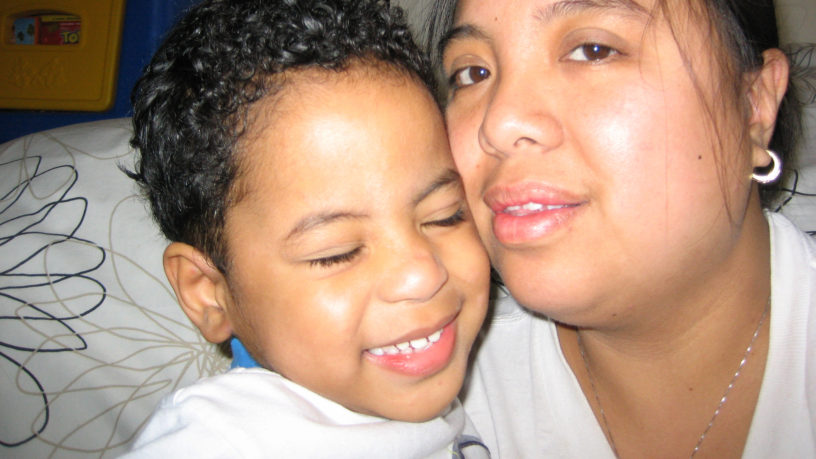By Jonathan Reynoso

“Kain na,” my Lola—meaning ‘grandma’ in Tagalog—yells to me early on a bright Sunday morning. Along with the sound of her voice, I often wake up to the sweet smell of longanisa, spam, eggs and fried rice she made with the leftover adobo from last night’s dinner.
This is a common occurrence in my household, as my Lola was not just the master of breakfast, she’s also the master of the kitchen and arguably, the best cook in the world. That’s probably why some of my jeans don’t fit me anymore.
Every day, I thank God that I grew up with my Lolo and Lola because I’ve experienced so much of my Filipino culture through them. The close relationship I’ve been able to have with them has helped me feel more connected to my identity. From the Christmas parties where we sing karaoke and through every time I help my little cousins collect their alamusa to regular family gatherings, I’ve constantly immersed myself in my Filipino heritage.
Being both Jamaican and Filipino, I always take pride in where I come from. It’s such a unique experience to be involved with and embrace the multiple cultures you’re born in. It’s like having VIP access to a club, but I’m in my own booth, vibing to dancehall like “mi a boss.” While I’m tearing up some spiked calamansi juice, cooling me down as if I was chilling on the coastlines of Boracay. Just don’t tell my mom I put rum in the calamansi.
As a mixed kid in Scarborough, Ont., I admit I’ve had it easy growing up. I mean, wherever I went, I’d always see someone who looked like me. Despite growing up without the presence of my dad for the majority of my life, I still felt connected to my Jamaican heritage.
Whether it meant going to my ninang’s—meaning ‘godmother’ in Tagalog— house to tear up some of my uncle Danny’s oxtail and rice and peas or my mom bumping some Sanchez in her car I never felt disconnected.
During the first 20 years of my life, I’ve always had a sense of belonging. However, that doesn’t mean it hasn’t been tested. To this day, I still get asked, “Which side do you feel closer to?” I never hesitate to say both.
I remember a time in high school when I was sitting down for lunch. Some students who weren’t Black claimed to be “more Black” than me purely based on the ways society thinks Black people act. This made me question where I belonged and where I fit in. From this point I have felt so comfortable of where I was in this world when I came to my identity, just to feel like I don’t belong.
I don’t smoke weed and I don’t throw around the n-word, but those are not things that showcase Blackness. Waking up, walking around and carrying myself with pride is showing my Blackness, not the stereotypes that are meant to place people like me in a box to define who we are.
Waking up, walking around and carrying myself with pride is showing my Blackness
Simply on the basis of my physical appearance, many people refuse to believe I’m also Filipino. They’ll doubt me until I pull out my very limited Tagalog vocabulary, and without fail, make their jaw drop. It’s even funnier that some of my family members are surprised that I know so much about my Filipino culture.
Growing up on my mom’s side, I’ve kind of held the responsibility of building the bridge between cultures. This led to me acting as a teacher for my families, educating each side on traditions and customs practiced by the other. Luckily, my mom’s side of the family has resided in the Greater Toronto Area—specifically Scarborough, Ont.—for many years now. So, experiencing other cultures hasn’t been a foreign concept to them.
This part of the city is like a melting pot, being home to over hundreds of different ethnic backgrounds. It’s a place that will never cease to celebrate different ethnicities through community-hosted events or gatherings at Thompson Park, which is one of many social opportunities available for residents to come together.
Unfortunately, experience doesn’t always mean that it’ll lead to understanding. That’s not to say my Filipino family has made me feel alienated or like I don’t belong, but there are some things I have to help them understand. For example, nobody on my mom’s side has hair like mine, so it was my job to teach them about the different hairstyles that fit my 3c hair type.
When I was interviewed on my experiences with my hair in an Eyeopener feature, “Let’s Talk Texture,” I shared how some of my family members were conditioned to believe certain stereotypes about people who have a similar hair texture like me, thinking that it was unprofessional and untidy. This experience led me to have to carry the weight of educating them.
I went through a whirlwind of emotions the first time I braided my hair. When I first asked my Lola for permission to do it, the four words, “Not until I’m dead,” firmly left her mouth along with a stone-cold expression. Those words aren’t something you’d want to hear from your own grandmother.
Months later I mustered up the courage and went against her wishes. However, those same four words echoed in my head as I blankly stared into space on the bus on my way to my hairstylist.
When I was going back home after my appointment, my forehead was glistening with sweat from having my new braids pulling back my scalp after a fresh cut. My hair smelled of hair mousse and blackseed oil as I headed upstairs to show my grandmother my new cornrows. To my pleasant surprise, she ended up liking the braids on me. She was happy that my long curls weren’t covering my face anymore, which had been covered since I started growing out my hair.
By getting my hair braided, I was able to show my family that cornrows could make me look clean and neat, helping to break down stereotypes they had about Black men with braids.
Through the years, I’ve heard about kids from different cultures and backgrounds who get scrutinized for something as simple as a hairstyle or embracing parts of who they truly are. I’m an advocate for representing all parts of where you come from, in any capacity you can.
We are all unique and special, so to suppress parts of ourselves to fit in or feel comfortable is doing us a disservice. From someone who’s come to a better understanding of accepting my identity, learn to say “fuck what other people think” because you are you. Nobody can ever take your identity away from you and accepting that you belong is the first step.










Leave a Reply